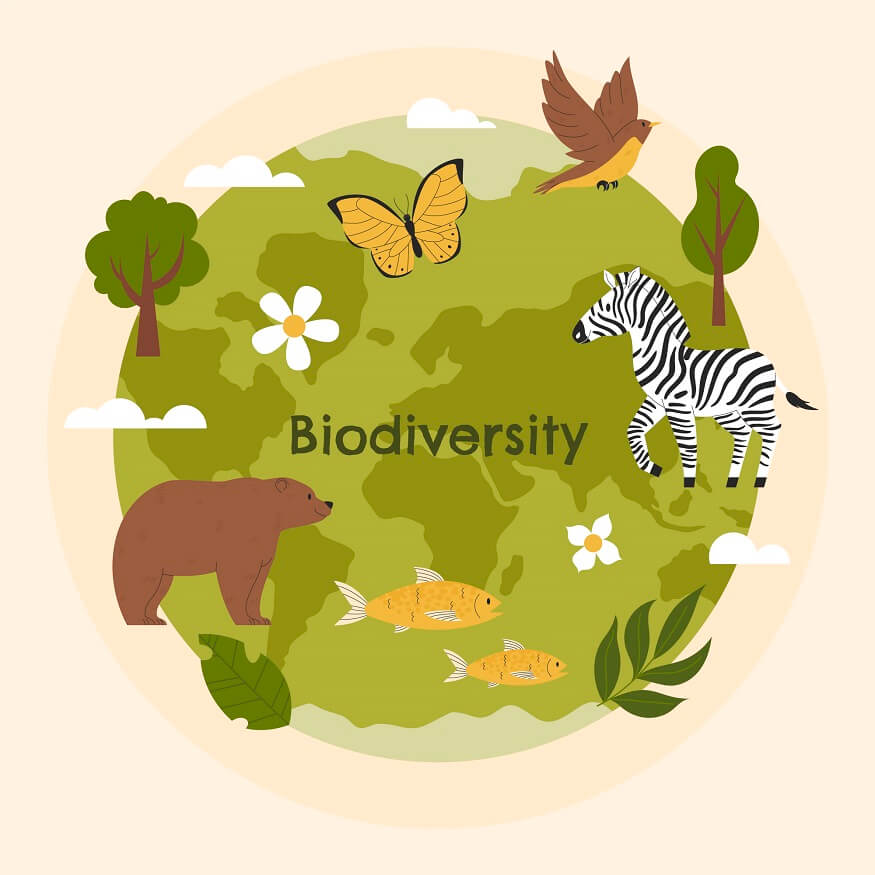Teaching kids about biodiversity meaning, benefits of biodiversity, importance of biodiversity and ways to converse biodiversity, how nature lives in a delicate balance is a terrific approach to inspire them to feel a connection to the natural world.
What is Biodiversity?
Biodiversity means “Biological diversity” which refers to the variety of living things found in all habitats, such as terrestrial, marine, and other aquatic ecosystems, as well as the ecological systems to which they belong.
Benefits of biodiversity
Several “nature-based solutions” to climate change and issues brought on by environmental changes involve biodiversity. Up to a third of the carbon emissions reductions required to achieve the Paris Agreement goals might be achieved with these solutions.
Also Read: Environmental Safety for Kids
Importance of Biodiversity
By supplying ‘ecosystem services,’ which include food, water, energy, and carbon sequestration, healthy and functional ecosystems play a critical role in sustaining human livelihoods.
This article shows activities that kids may do in their neighbourhood to support biodiversity, as well as resources to assist you in teaching kids why biodiversity is crucial for future generations. Through outdoor gardening and animal watching activities that families may participate in together, these activities will offer the chance to learn about how to enhance biodiversity for bees, birds, bugs, insects, and plant life in Canada.
- Bottle Biospheres
- Create Your creature
- A web of life.
- Build A Birds Nest & Feeder
- Create A Garden
- Endangered species Bingo
- Collages
- Biodiversity Hospital
- Create a Bug hotel
- Mussel Invasion
- Cone dissection
- Design an Ecosystem
- UV Light and Plant Growth Investigation
- Frog Population study
A great hands-on activity to teach pupils about biodiversity’s meaning and microbiological diversity is making bottle biospheres. A quick walk to a nearby lake or pond and a few plastic bottles are all you need! The upkeep of a healthy environment will be the responsibility of the students to ensure the survival and reproduction of their organisms, ensuring ways to conserve biodiversity.
A fantastic technique to teach about the importance of biodiversity and species diversity is through creature construction. Why not introduce a handful of the many millions of species that inhabit the world, then have pupils design their own while learning about their adaptations and organ systems? For younger kids, this simple and enjoyable project is excellent as a start to their animal subject.
Building a food web is an incredible ecosystem diversity activity in which students will discover the relationship between living things. Each student will become a plant, animal, or food. Then they will use a string to map out how energy is transferred from one organism to the next.
Making a bird’s nest or a bird feeder is a quick and enjoyable biodiversity exercise that can help students see an increase in the importance of biodiversity in their own backyard. Students can graph the variety of birds they see at their feeders while learning about the kinds of plants or foods that birds prefer.
Making a garden is one method to learn about different plant species! Students can examine the variations of plants that people utilise daily as well as the distinctions between them. Additionally, this is an excellent practice for teaching about the requirements of plants and other living things.
You can start a discussion regarding biodiversity loss as a result of human activities if your class is studying biodiversity in greater depth. How do people impact the environment? What are the names of the impacted animals? With the help of this fantastic bingo game, kids can learn about endangered species and discover which animals need our assistance and how.
Also Read: What is nature-based early childhood education
Making a collage on animals and what biodiversity means to them is a great way to introduce benefits of biodiversity and its definition. These resources will inspire a class conversation about biodiversity and its significance to life, whether it is with pictures and illustrations of various species or complete ecosystems.
Use this enjoyable game to expand your lesson of the importance of biodiversity after discussing endangered species and how human activity affects animals. To decide whether an animal is threatened, vulnerable, endangered, or nearly extinct, students will examine each one as a patient.
A fantastic technique to study organisms and adult insects is by building a bug hotel. Students can cut a water bottle and fill it with various materials, such as dirt, rocks, and sticks. After that, set it outside where worms and adult insects can find it. Students can check to see what creatures have entered and made themselves at home in their hotel after a week.
Also Read: Fun Bird Activities for Children To Enjoy
Studying mussels is a fantastic approach to educate students about invasive species and the benefits of biodiversity and how they impact ecology. By learning about the detrimental effects of invasive species and overcrowding on the rest of the environment, students will expand their understanding of balanced ecosystems.
Pinecone dissection is a fantastic approach to learning about various plant species. Students can deepen their learning about ways to conserve biodiversity by naming each component of the pinecone and classifying the various species they discover in their environment. Additionally, students can investigate the various microbes that coexist in the microscopic ecology of a pinecone.
Like bottle biodiversity, children will create their own environment in this project. Students can pick an animal and then construct an ecosystem and home for that animal in a little box. The interactions within each ecosystem teach them ways to conserve biodiversity, whether it be in a severe setting or an urban context, which will be covered by the students.
If you are learning about plants and biodiversity meaning, do a UV light and plant growth investigation! Students will learn about the needs of plants and create an experiment to determine which type of light is better for plant growth. Not only will they learn crucial science skills, but maths as well!
A study of frog populations can be used to teach older children about biodiversity meaning ecosystems and interactions within the environment. In accordance with the cards they choose, students will utilise dice and beads to alter the environment. Who will end up with the most frogs? Will a predator perish and increase the frog population, or will an alien species reduce it? The children will be engrossed in this game until the very last card, making it ideal for the classroom.
Also Read: Ethnobotany: Meaning, Types and applications of ethnobotany
Conclusion:
Euroschool teaches kids biodiversity, meaning thoroughly as the diversity of life on Earth, and it ranges from minuscule, microscopic species to entire ecosystems and biomes! Each organism and species contributes to the environment that supports people and other animals. With our variety of practical biodiversity activities, you may instruct your kids on the value of protecting the environment and getting along with other animals.










